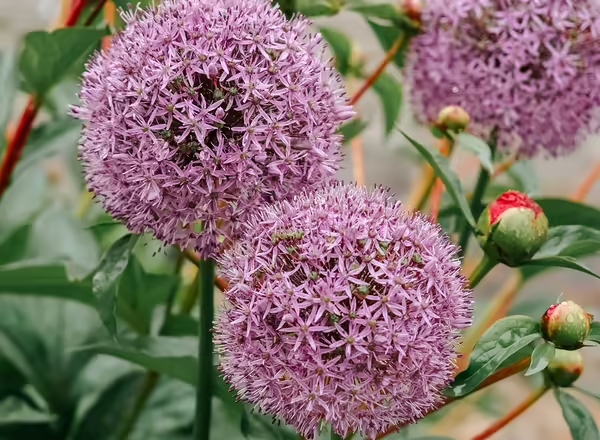
Family: Amaryllidaceae (Amaryllis) Zone 5
How to Plant: bulb; plant 6 to 8 inches deep and one foot apart in the fall
Habit: upright in foliage and flower
Foliage: bluish gray; strap-shaped; 18 inches long; 2 to 4 inches wide
Flower: pinkish purple; borne in dense globe-shaped cluster 4 to 6 inches across; flower stalk 3 to 4 feet tall; late spring to early summer
Culture: ordinary soil; full sun or partial shade; dramatic in flower - plant in clusters of 5 to 7 bulbs; usually planted in back of the perennial border; long-lasting as cut flower

Family: Ranunculaceae (Buttercup) Zone 6
How to Plant: tuberous root; plant 2 to 3 inches deep and 3 to 4 inches apart
Habit: mounded; less than 6 inches
Foliage: 1 or 2 dark green basal leaves; divided; dies down by midsummer
Flower: no true petals - has petal-like sepals; daisy-like flowers 1-1/2 to 2 inches wide; white, pinkish, blue and white; early spring
Culture: humus-rich, loamy soil; tolerated high pH; partial shade and protection from wind prolongs flowering
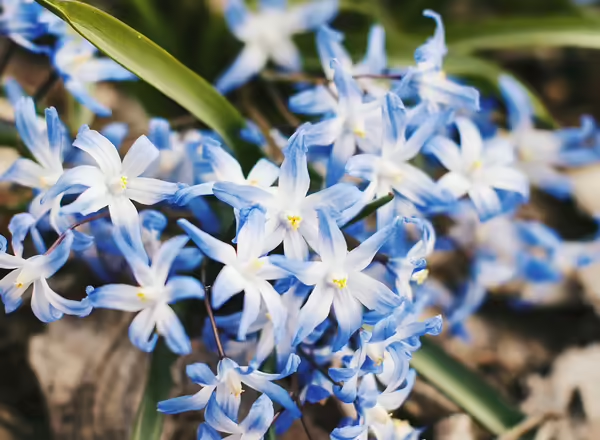
Family: Liliaceae (Lily) Zone 4
How to Plant: bulb; plant 3 inches deep and 3 inches apart in fall
Habit: upright; 3 to 6 inches
Foliage: grasslike; dark green; 2 leaves per stem
Flower: blue with white center; about 5 in a cluster; each flower 1 inch across; star-like flowers borne on a reddish stalk that extends above foliage; early spring
Culture: ordinary, well-drained soil; suitable for under-planting deciduous shrubs; plant in masses for immediate effect; will multiply slowly by self seeding

Family: Iridaceae (Iris) Zone 4
How to Plant: corm; plant 3 inches deep and 4 inches apart in fall
Habit: upright; 6 inches
Foliage: grasslike; dark green; curved; silver striped down center of leaf; leaves shorter than flowers, then expand to 8 to 12 inches after flowering
Flower: 1 1 /2 to 8 inches long; white, yellow, purple or striped; usually borne singly; close at night or on cloudy days; spring
Culture: plant in well-drained soil; full sun or partial shade; may be naturalized in lawns if foliage is allowed to ripen properly
Note: There are 3 main groups of crocus: C. chrysanthus (Golden Crocus) flowers very early and has small flowers; C. vernus (Dutch Crocus) is most popular and has larger flowers (many named cultivars of crocus are in this group); the third group is comprised of botanic species, that tend to have small, brightly colored flowers. There are Crocus species that flower in autumn.
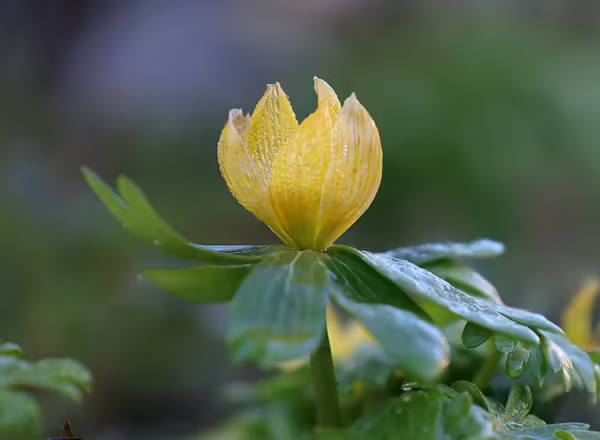
Family: Ranunculaceae (Buttercup) Zone 4
How to Plant: tuber; plant 3 inches deep and 4 to 6 inches apart in early fall; soak tubers overnight before planting
Habit: upright; 3 to 8 inches
Foliage: basal; long petioles; deeply divided; leafy bract situated immediately under flower; actual foliage develops as flowering ends; dies down in summer
Flower: solitary; one inch across; yellow petallike sepals; very early spring
Culture: partial shade to full sun; well-drained, moist soil; plant in masses; good for naturalizing; will self-sow
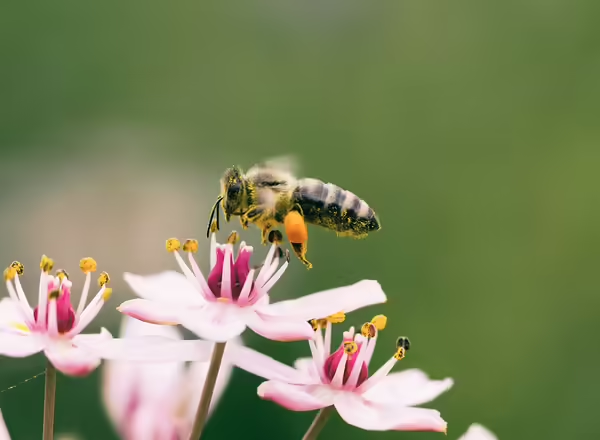
Family: Liliaceae (Lily) Zone 4
How to Plant: bulb; plant 4 to 6 inches deep and 4 to 6 inches apart in early fall
Habit: erect; 9 to 15 inches
Foliage: few, alternate leaves; linear; 3 to 6 inches long
Flower: drooping; usually solitary; white or mottled and veined with bronze, gray, purple and white; 1-1/2 inches long; spring
Culture: full sun or light shade; moist, well-drained soil; propagate by dividing after foliage ripens
Note: Arelated species, F. imperialis (Crown Imperial), bears several pendant flowers atop a 2 to 4 foot stalk with a tuft of leaves at the top of the stalk; flowers are bright yellow or orange.
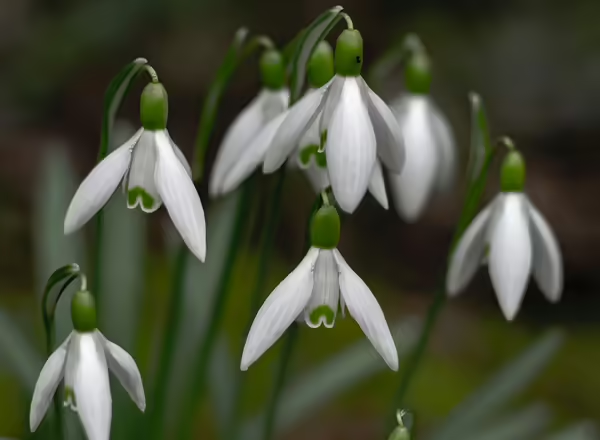
Family: Amaryllidaceae (Amaryllis) Zone 4
How to Plant: bulb; plant 3 inches deep and 3 inches apart in fall
Habit: upright; 6 to 8 inches
Foliage: 2 to 3 leaves; 1/4 inch wide; 6 inches long
Flower: white except for green crescent around the notch of inner floral segments; external floral segments longer than inner ones; flower drooping; 1/2 inch across; borne on slender stalk; very early spring; cultivars may have more green in flowers or be doubled
Culture: partial to full shade; moist, well-drained soil with high organic matter; naturalize in large drifts; propagate by dividing clumps immediately after flowering

Family: Liliaceae (Lily) Zone 5
How to Plant: bulb; plant 7 inches deep and 6 to 9 inches apart in fall
Habit: upright; 12 inches
Foliage: 4 to 6 basal leaves; strap-shaped; margins upturned; 1 inch wide and up to 12 inches long
Flower: many flowers in showy, crowded, terminal raceme; individual flowers about 1 inch across; very fragrant; yellow, rose, pink, blue, salmon and white; mid-spring
Culture: full sun; good drainage; fertile soil amended with organic matter and sand; remove spent flower stalks; floral display gradually decreases each year - dig and discard bulbs as necessary; flowers too rigid for naturalizing; many named cultivars available

Family: Iridaceae (Iris) Zone 6
How to Plant: bulb; plant 5 inches deep and 4 to 6 inches apart in the fall
Habit: upright; 1-1/2 to 2 feet
Foliage: leaves almost cylindrical; up to 2 feet long; tips of leaves may tend to die back
Flower: 1 or 2 flowers; 3 to 4 inches across; white, yellow, orange, bronze, blue, purple or bicolor; late spring
Culture: full sun; well-drained soil; dry, warm soil in summer is ideal; good for forcing indoors
Note: Dutch Hybrid Iris originated by crossing Spanish Iris (Iris xiphium) with several other Iris species; Dutch Iris is a common cut flower used by florists

Family: Liliaceae (Lily) Zone 4
How to Plant: bulb; plant 3 inches deep and 4 inches apart in early fall
Habit: upright; 6 to 12 inches
Foliage: 6 to 8 basal leaves; up to 12 inches long and 1/3 inch wide; dark green on lower surface; appear in autumn and remain green through winter; dormant in summer
Flower: 12 to 20 flowers in terminal cluster on leafless flower stem; each flower urn shaped and drooping; blue or white; 1/8 inch long; early spring
Culture: fertile, sandy soil in full sun or partial shade; plant in masses for best effect
Note: Arelated species, M. armeniacum, self seeds more aggressively and is more invasive.

Family: Amaryllidaceae (Amaryllis) Zone varies
How to Plant: bulb; plant 6 inches deep and 6 to 12 inches apart (smaller species bulbs require more shallow placement)
Habit: upright; 6 to 24 inches
Foliage: about 3/4 inch wide; up to 15 inches long; shiny green
Flower: one or several flowers to a stalk; 6 lower segments white or yellow; trumpet long and tubular or short and cuplike, white, pink, yellow, orange and orange-red; flowers single or double; extremely variable - Narcissus are grouped into 12 named divisions; early spring to spring
Culture: well-drained soil enriched with organic matter; divide every fourth year after leaves have died; easy to grow; remove faded flowers so they don’t set seeds
Note: The name daffodil applies primarily to flowers with large trumpets and can be used for all members of the genus; the name jonquil originally applied only to N. jonquilla, but now is usually applied to all jonquilla daffodils of garden origin (Division 7); the name narcissus is derived from the genus name Narcissus.
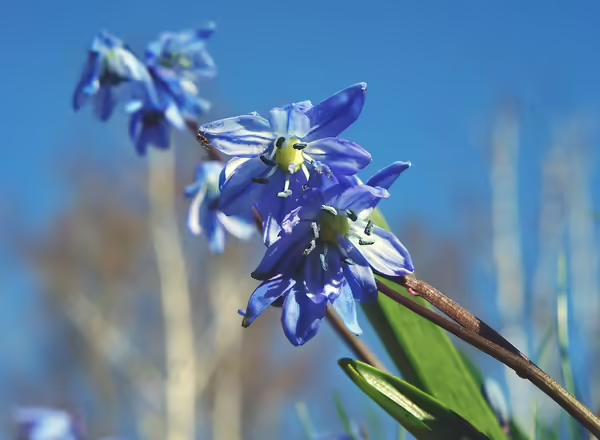
Family: Liliaceae (Lily) Zone 4
How to Plant: bulb; plant 3 inches deep and 4 to 6 inches apart in early fall
Habit: upright; 6 inches
Foliage: 2 to 5 grasslike, basal leaves; 6 inches long and 1/2 inch wide; blunt tipped and bright green
Flower: deep blue; bell shaped; 1/2 inch wide; in loose cluster of 3 to 5; 1 to 6 flower stems per plant; early spring
Culture: fertile, sandy soil in sun or partial shade; useful under deciduous shrubs and trees; plant in large masses for best effect; tend to colonize over time; suitable for naturalizing in the lawn (foliage matures quickly before turfgrass needs cutting)

Family: Liliaceae (Lily) Zone varies
How to Plant: bulb; plant 4 to 8 inches deep and 4 to 8 inches apart in fall; deep planting (within reason) discourages bulbs multiplication and encourages good-sized flowers for several years; species tulips usually require shallower planting
Habit: upright or clumped; 6 to 30 inches
Foliage: usually basal; thick bluish green; untoothed; 6 to 10 inches long; Kaufmanniana and Greigii hybrids often have burgundy-or purple-mottled leaves
Flower: usually solitary; erect; saucer-shaped; total of 6 petals and sepals (except doubles); multitude of colors and flower forms (there are over 400 named cultivars: common classes are Mendel, Fosteriana hybrids, Kaufmanniana hybrids, Greigii hybrids, Triumph, Darwin hybrid, Lily-flowered, Cottage, Rembrandt, Parrot, Double-flowered and Species tulips); early spring to spring
Culture: well-drained, sandy, humus-rich soil in full sun or partial shade; plant in masses; bulbs may be moved or discarded in midsummer after foliage has withered; some gardeners plant new bulbs each year; remove faded flowers to avoid seed set